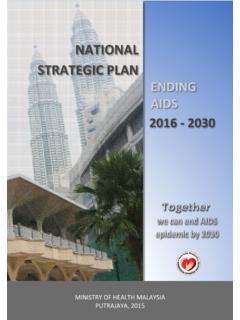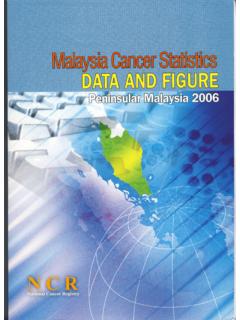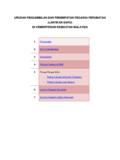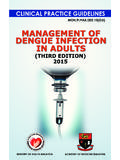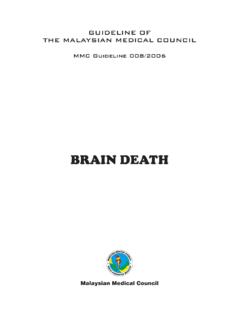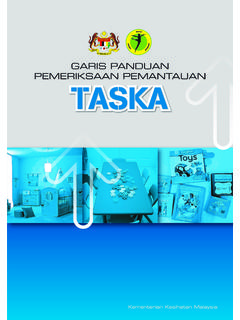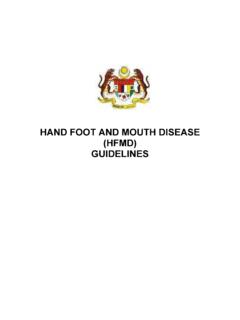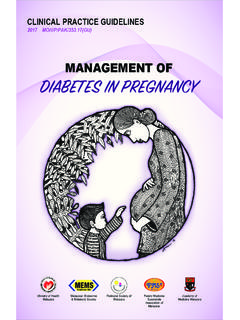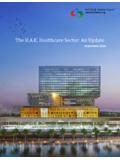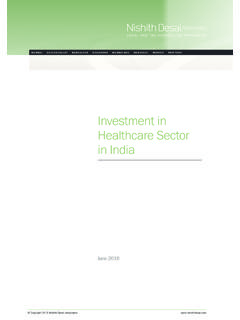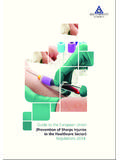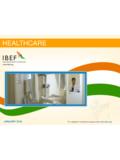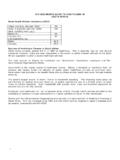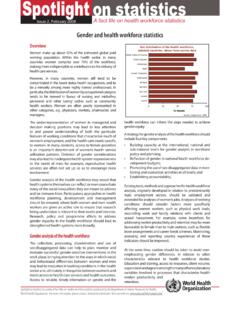Transcription of Healthcare - moh.gov.my
1 Chapter Healthcare16553 Economic Transformation ProgrammeA Roadmap For MalaysiaChapter 16: CreatingWealth Through Excellencein Healthcare Healthcare is now at the cross-roads. While maintaining focus towards providing for the health and well-being of Malaysians, we also realised the unlimited economic potential of this sector. We are aware that Healthcare sector is also a wealth creator. Beyond just the organic growth in services, pharmaceuticals and medical devices, we will explore new horizons in services, clinical research, health travel, and generics pharmaceuticals manufacturing. In this journey, we aspire to contribute to GNI by 2020. To achieve this, I seek the support of all Healthcare providers, corporations and organizations. Dato Sri Liow Tiong LaiMinister of Health he global Healthcare industry is among the most dynamic and rapidly growing industries in the world economy.
2 Spurred by demographic shifts such as extended longevity and a rise in lifestyle diseases such as hypertension and cardiovascular ailments, cancer and diabetes, national Healthcare costs are increasing dramatically. At the same time the health industry has become a powerful engine of economic growth. Malaysia s record of Healthcare expenditures is no exception to the rule. At percent of GDP, our spending on Healthcare is above our regional peers and public spending is a disproportionate contributor to Healthcare costs. The burden on public spending is even more pronounced when compared to countries in the upper-middle to high-income brackets (Exhibit 16-1). While numerous efforts are already underway to stem the expenditure trajectory, there is no coordinated effort to grow Healthcare revenues.
3 The Healthcare NKEA intends to address this asymmetry of focus and identify private sector opportunities to reframe health as an economic commodity as well as a social 16 Creating Wealth Through Excellence in HealthcareExhibit 16-1 DEFINITION OF THE Healthcare NKEAW hile it is easy to develop a singular focus on Healthcare as a cost and view managing these costs as the critical agenda, it is time for Malaysia to reframe the discussion. The Healthcare industry can be a robust economic engine and one that indirectly creates significant social impact. Higher value jobs can be created, infrastructure can be upgraded and both specialist skill-sets and technology can be harnessed to improve the quality of care for patients. When examined from a profitability and growth lens, the Malaysian health sector opportunity looks extremely attractive despite its modest beginnings.
4 As seen in Exhibit 16-2, all three key sub-sectors of the larger Healthcare ecosystem, pharmaceuticals and biotechnology, medical technology (med tech) and health travel, have delivered stronger performances relative to the larger, more traditional economic sectors such as automotive, agriculture and electronics. 555 Economic Transformation ProgrammeA Roadmap For MalaysiaExhibit 16-2 The growth of the Healthcare industry in Malaysia has been organic in nature and is primarily driven by domestic consumption of Healthcare products and services. Moving forward, it is now time to reframe and position Healthcare as an engine of economic ensure the right balance of breadth and depth of coverage, the Healthcare NKEA is focused on the larger sub-sectors within the Healthcare ecosystem.
5 These include bio-pharmaceuticals, med tech, private Healthcare financing and health services. Wellness services as related to traditional and complementary medicine (T&CM) are considered out of scope for the Healthcare NKEA given the infancy of the industry, fragmentation of the competitive landscape and the fact that until the enactment of the T&CM Bill, the boundaries of T&CM are still not well defined. As seen in Exhibit 16-3 our expectation is that focus on the largest economic engines will directly impact the Healthcare infrastructure and indirectly result in better quality care for the rakyat. For example, the increase in hospital beds, doctors and nurses as a result of the growth in the Healthcare industry should reduce wait times for patients, shorten the turnaround time on diagnostic lab results and improve the quality of patient outcomes through access to more specialist care centres.
6 556 Chapter 16 Creating Wealth Through Excellence in HealthcareExhibit 16-3 MARKET ASSESSMENTM alaysia is in a unique position today. We can either aggressively participate in the global shift towards Asia by becoming a major player in the region s Healthcare arena, or we can become marginalised as less developed countries such as Indonesia and less expensive countries such as Vietnam play larger roles on the ASEAN stage. Indonesia and Vietnam are already positioning themselves for Healthcare growth. In Indonesia, local pharmaceutical companies are capturing an increasing share of the domestic market. In Vietnam extensive commitments and strong government support are going towards growing the med tech sub-sector through developing infrastructure and building a skilled, low-cost labour force.
7 Malaysia must act now and determine how best to use its infrastructure capabilities, domestic consumption base and diverse population to create an economic growth agenda for Healthcare . Recent indicators show that despite fundamentals being at risk, the Malaysian Healthcare industry has a solid starting point to undertake an economic transformation (Exhibit 16-4). 557 Economic Transformation ProgrammeA Roadmap For MalaysiaExhibit 16-4 From Exhibit 16-4, we can see that there is a real opportunity to improve our position on each of the fundamental sub-sectors. Although RM422 billion of prescription and pharmaceutical drug patents are about to expire in the next 10 years, Malaysia remains a net importer of generic products. Despite the rapid growth in med tech products, Malaysia remains focused on one category of products, medical consumables, which are primarily rubber-based products.
8 The emphasis on lower-value products has resulted in Malaysia not fully developing the more profitable med tech sub-sectors such as medical devices, diagnostic equipment and Healthcare information technology. Finally, the health travel industry in Malaysia remains small and fragile and in 2009 declined by four percent. This can be primarily attributed to the lack of clear positioning relative to peers and an insufficient network of partners for source patients. In contrast neighbouring countries such as Singapore and Thailand continued to grow during the same period and leveraged price, quality of care and an overall health travel experience to retain volume. It is critical for Malaysia to bounce back in this attractive beds per thousand and doctors per thousand as of 2008, Malaysia has a solid foundation to build on.
9 In addition the high incidence of lifestyle diseases and experience with quality assurance permits Malaysia to be a credible R&D and clinical trial destination for the pharmaceutical and med tech industries. Our goal is to migrate from primarily a lower-value product strategy to a more comprehensive product, services and asset strategy that better leverages our competencies. 558 Chapter 16 Creating Wealth Through Excellence in HealthcareTARGETS AND ASPIRATIONSTo achieve our target incremental GNI growth of billion between 2010 and 2020 aggressive targets will be set for each sub-sector. For pharmaceuticals, we are targeting a 22 percent GNI growth rate that will deliver billion GNI by 2020. This is driven by higher exports of generic pharmaceuticals and enhanced generics and increased clinical research in Malaysia.
10 The impetus for this aggressive growth is two-fold. First, we believe that significant extra capacity in the domestic pharmaceuticals industry can be re-focused on higher value manufacturing. Second, we believe that through investment in research and development, original research and product innovation, we can create a sustainable and thriving pharmaceutical industry. In the services sector, we are targeting a GNI growth of 10 percent which will result in a GNI of billion by 2020. Driving this growth is an increased emphasis on export-focused services such as health travel, specialist care centres and seniors living. Finally our planned growth in med tech remains a moderate eight percent. We believe that in the next 10 years growth will continue to come from the export of consumables to new markets, but towards the end of the next decade a new higher margin industry will emerge.

